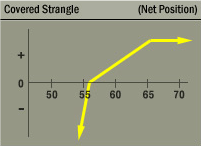Covered Strangle (Covered Combination)
This strategy is appropriate for a stock considered to be fairly valued.
Description
This strategy consists of two parts: (1) short a call and long the underlying stock, and (2) short a put with sufficient cash to purchase the stock if assigned. This is a combination of the covered call and cash-secured put strategies. If the stock rises above the call strike at expiration, the investor is most likely assigned on the call, which means selling their stock at the call strike. If the stock falls below the put strike at expiration, the investor is more than likely assigned on the put and obligated to buy more stock at the put strike.
Outlook
Looking for underlying stock to trade in a narrow range during the life of options.
Summary
This strategy is appropriate for a stock considered to be fairly valued. The investor has a long stock position and is willing to sell the stock if it goes higher or buy more of the stock if it goes lower.

EXAMPLE
- Long 100 shares stock
- Short 1 65 call
- Short 1 55 put
- Long $5,500 T-Bill (cash that covers potential put assignment)
MAXIMUM GAIN
- Call strike - stock purchase price + net premium received
MAXIMUM LOSS
- Stock purchase price + put strike - net premium received (substantial)
Motivation
Profit from a sideways to slightly-higher appreciation in the underlying. This is a classic option strategy for an investor who wants to increase their holding in the underlying stock should the market decline or decrease their holding should the market rise.
Variations
A variation of this strategy is a covered straddle. The only difference is that both the call and put options have the same strike price, but the underlying concepts would still apply.
Max Loss
The maximum loss would occur should the stock become worthless. In that case, the investor would have lost the entire value of their stock; half purchased initially when putting on the strategy and half as a result of assignment on their put option. The loss would be reduced by the premium received for selling the options. The risk is only on the downside, since a move by the stock above the call strike results in assignment and consequently liquidation of the position at a profit.
Max Gain
The maximum gain would occur if the stock were above the call strike price at expiration. In that case the investor would be assigned on the call and sell their stock at the call strike price, consequently closing out their position. In addition to the profit from buying and selling the stock, the investor would pocket the premium received from selling both options.
Profit/Loss
During the life of the options, the potential profit is limited, while the potential loss is substantial. However, since the loss scenario involves acquiring additional stock, it is entirely possible that should the investor simply hold on to their stock, the short-term unrealized loss could eventually become a long-term gain.
The riskiness of this strategy is to a large extent a function of the investor's motivation. If the investor is long-term bullish, a slight initial loss might actually be the desired scenario since it increases their stockholding at a much lower cost, and the maximum gain might be somewhat undesirable since it liquidates the stockholding and the investor was never assigned on the put.
Breakeven
The concept of breakeven for this strategy is somewhat nebulous, since if the investor is assigned on their short put the profit/loss will fluctuate for as long as the stock is held. Technically speaking, the strategy breaks even if the stock price at expiration is below the original stock price by the amount of premium received for selling the options (or below the average of the initial stock price and the put strike price if the put was exercised). Notice again, however, that if the original stock was purchased at a significantly lower price than the put strike (quite possible if the purchase took place long ago) this breakeven may lack any relevance.
Volatility
An increase in implied volatility, all other things equal, would have a negative impact on this strategy. Some investors use this strategy as a way to play volatility. If the stock price held steady and implied volatility quickly dropped, the investor might conceivably be able to close out the position for a profit well before expiration.
Time Decay
The passage of time, all other things equal, will have a positive impact on this strategy. Every day that passes without a move in the stock price brings both options one day closer to expiring worthless.
Assignment Risk
Slight. This strategy is explicitly based on the investor being willing and able to take the assignment on either option. At worst, an early assignment would only cause the investor to lose some interest or dividend income. Early assignment, while possible at any time, generally occurs for a call when the stock goes ex-dividend or for a put when it goes deep in-the-money.
And be aware, a situation where a stock is involved in a restructuring or capitalization event, such as a merger, takeover, spin-off or special dividend, could completely upset typical expectations regarding early exercise of options on the stock.
Expiration Risk
None. The strategy explicitly assumes a willingness to buy more stock if the price declines and to sell stock if the price rises, thus implying that the investor is indifferent to whether or not they are assigned on either option.
Comments
N/A
Related Position
Comparable Position: N/A
Opposite Position: N/A

